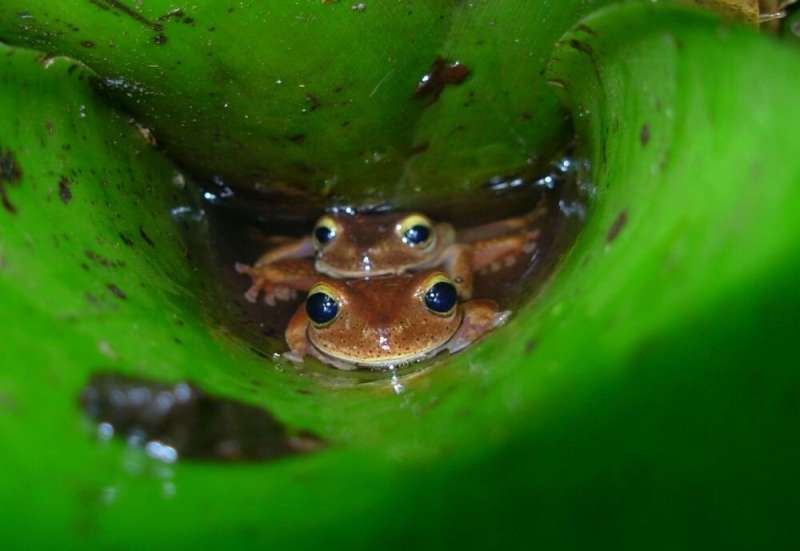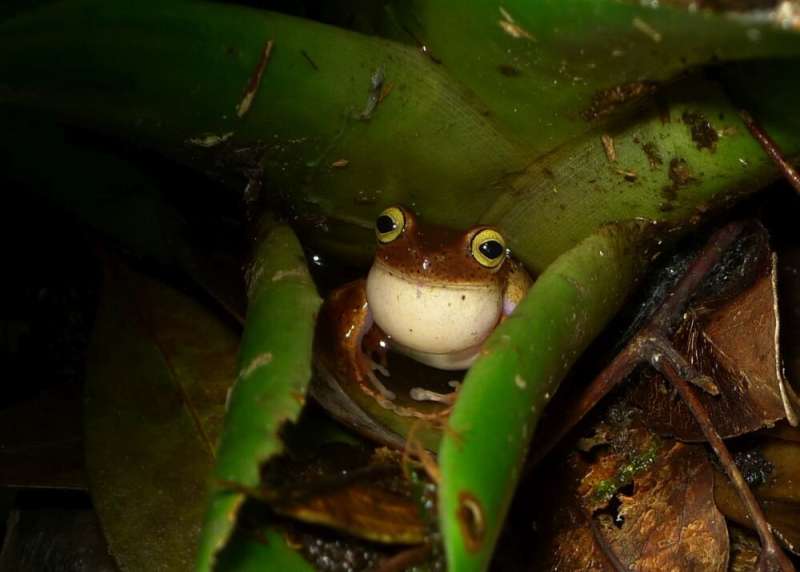#Unusual breeding behavior reported in treefrogs for the first time

“#Unusual breeding behavior reported in treefrogs for the first time”

Paranapiacaba Treefrogs (Bokermannohyla astartea) mate and lay spawn in small pools of water inside the tanks of bromeliad plants, Leo Ramos Malagoli from the Universidade Estadual Paulista in Brazil and colleagues report in the open-access journal PLOS ONE. The 3cm-long tadpoles must then make their way to a stream to complete development. The study, publishing February 17, is the first to report this unusual reproductive strategy in frogs.
The researchers spent 11 years collecting data on the courtship behaviours, mating, spawning, and tadpole development in this little-known species, which is endemic to the Atlantic Forests of Brazil. They observed Paranapiacaba Treefrog males calling from bromeliad ponds (known as ‘leaf-tanks’) located on the banks of streams. Females mated with males inside the leaf-tanks and laid their spawn there, but the researchers found that the tadpoles did not complete their entire development in the tanks. Tadpoles at or beyond the 26th stage of development were found exclusively in the neighbouring stream, suggesting that they fall, jump, or are washed out of the tank to complete their development in a large body of water, the authors say.

Many species of frog mate in leaf tanks, because they offer a safe location away from predators and competitors. But the frogs usually relocate to lay their eggs in ponds or streams, or the tadpoles remain in the tank until adulthood. The unusual developmental strategy reported for Paranapiacaba Treefrogs allows the tadpoles to grow in a safe location, and to escape before limited food and space in the leaf tank runs out. The authors suggest that high summer rainfall in the Atlantic forests of southeast Brazil may have helped this unique strategy evolve. The study adds to the remarkable reproductive diversity of frogs, which exhibit the largest number of different breeding strategies of all four-legged vertebrates.
The authors add: “[This paper describes] a new reproductive mode in anurans recorded in an endemic treefrog of the Brazilian Atlantic Forest.”

Not too big, not too small—tree frogs choose pools that are just right
Malagoli LR, Pezzuti TL, Bang DL, Faivovich J, Lyra ML, Giovanelli JGR, et al. (2021) A new reproductive mode in anurans: Natural history of Bokermannohyla astartea (Anura: Hylidae) with the description of its tadpole and vocal repertoire. PLoS ONE 16(2): e0246401. doi.org/10.1371/journal.pone.0246401
Citation:
Unusual breeding behavior reported in treefrogs for the first time (2021, February 17)
retrieved 18 February 2021
from https://phys.org/news/2021-02-unusual-behavior-treefrogs.html
This document is subject to copyright. Apart from any fair dealing for the purpose of private study or research, no
part may be reproduced without the written permission. The content is provided for information purposes only.
If you liked the article, do not forget to share it with your friends. Follow us on Google News too, click on the star and choose us from your favorites.
For forums sites go to Forum.BuradaBiliyorum.Com
If you want to read more Like this articles, you can visit our Science category.



